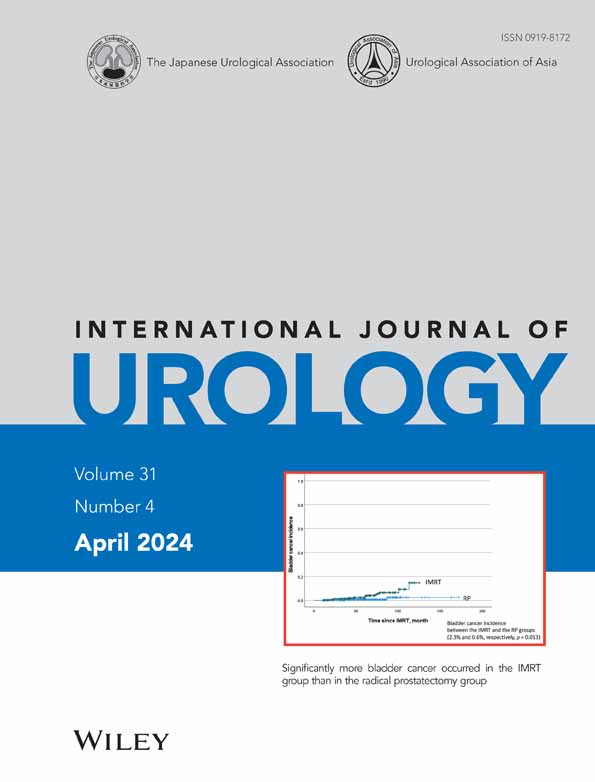GnRH antagonist monotherapy versus a GnRH agonist plus bicalutamide for advanced hormone-sensitive prostate cancer; KYUCOG-1401
Abstract
Objectives
To compare the effectiveness and safety of gonadotropin-releasing hormone (GnRH) antagonist monotherapy to combined androgen blockade (CAB) with a GnRH agonist and bicalutamide in patients with advanced hormone-sensitive prostate cancer (HSPC).
Methods
The study was conducted as KYUCOG-1401 trial (UMIN000014243) and enrolled 200 patients who were randomly assigned to either group A (GnRH antagonist monotherapy followed by the addition of bicalutamide) or group B (CAB by a GnRH agonist and bicalutamide). The primary endpoint was PSA progression-free survival. The secondary endpoints were the time to CAB treatment failure, radiographic progression-free survival, overall survival, changes in serum parameters, including PSA, hormones, and bone and lipid metabolic markers, and adverse events.
Results
PSA progression-free survival was significantly longer in group B (hazard ratio [HR], 95% confidence interval [CI]; 1.40, 1.01–1.95, p = 0.041). The time to CAB treatment failure was slightly longer in group A (HR, 95% CI; 0.80, 0.59–1.08, p = 0.146). No significant differences were observed in radiographic progression-free survival or overall survival. The percentage of patients with serum testosterone that did not reach the castration level was higher at 60 weeks (p = 0.046) in group A. No significant differences were noted in the serum levels of bone metabolic or lipid markers between the two groups. An injection site reaction was more frequent in group A.
Conclusions
The present results support the potential of CAB using a GnRH agonist and bicalutamide as a more effective treatment for advanced HSPC than GnRH antagonist monotherapy.
CONFLICT OF INTEREST STATEMENT
AY (Astellas Pharma Inc., Janssen Pharmaceutical K.K.), MS (Janssen Pharmaceutical K.K., AstraZeneca, Astellas Pharma Inc.), ME (Ono Pharmaceutical Co., Ltd., Takeda Pharmaceutical Co., Ltd., Novartis Pharma K.K., Pfizer Japan Inc., Bristol-Myers Squibb Co., Janssen Pharmaceutical K.K., MSD K.K., Merck Biopharma Co., Ltd., AstraZeneca, Eisai Co., Ltd.), HideM (Janssen Pharmaceutical K.K., Chugai Pharmaceutical Co., Ltd.), HE (Astellas Pharma Inc.), TI (Astellas Pharma Inc., Janssen Pharmaceutical K.K.), TK (AstraZeneca, Merck Biopharma Co., Ltd.) have lecture fees, honoraria, or other fees from each entity.
MS (Daiichi Sankyo Co., Ltd.), ME (Bristol-Myers Squibb Co., Ono Pharmaceutical Co., Ltd., Eisai Co., Ltd., Taiho Pharmaceutical Co., Ltd., MSD K.K.), HideM (Janssen Pharmaceutical K.K.), TK (Janssen Pharmaceutical K.K., Shin Nippon Biomedical Laboratories, Ltd., Ono Pharmaceutical Co., Ltd., Bayer Yakuhin, Ltd., Sanofi K.K., Takeda Pharmaceutical Co., Ltd.) have research funds from each entity.
ME (Sanofi K.K., Bayer Yakuhin, Astellas Pharma Inc, Ono Pharmaceutical Co., Ltd., Takeda Pharmaceutical Co., Ltd.), HideM (Kyowa Kirin Co., Ltd., Takeda Pharmaceutical Co., Ltd.) have scholarship (incentive) endowments or research grants from each entity.
FM, HiroM, NT, KK, ST, NF, KH, HS, TH, SS, YS, JK and SN have no COI to disclose.




